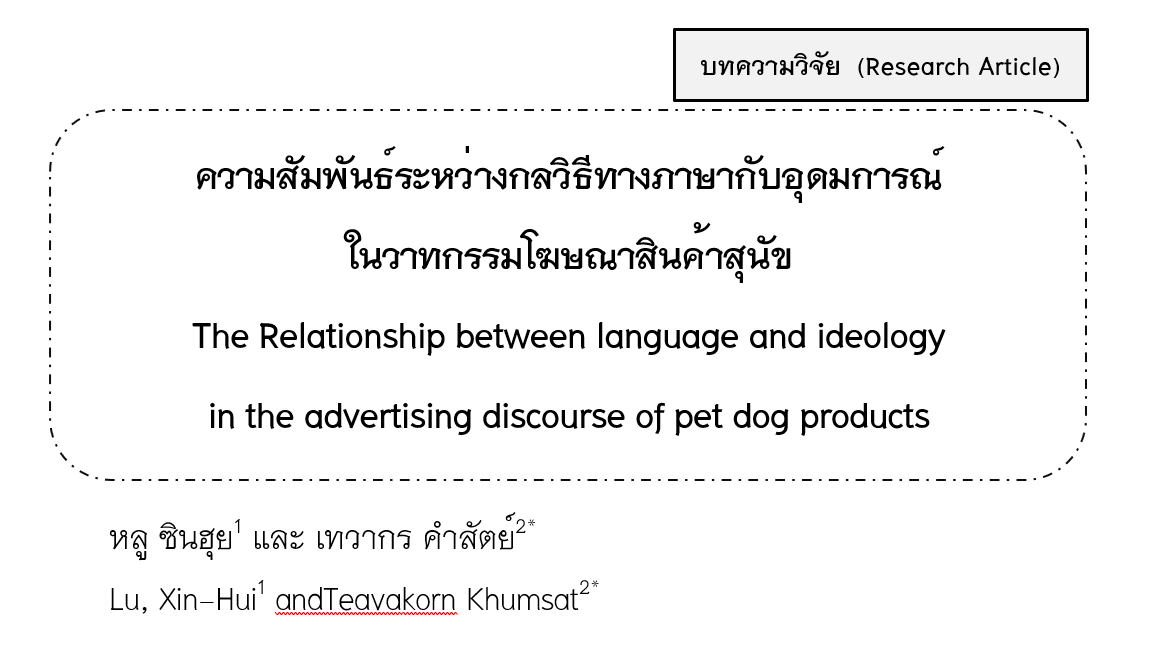The The Relationship Between Language and Ideology in the Advertising Discourse of Pet dog Products
Keywords:
Communication Strategies, Ideology, Advertising Discourse of Dog ProductsAbstract
This study aimed to investigate how advertising discourse used in dog products played a role in the construction of ideology about dogs based upon Fairclough’s Critical Discourse Analysis (CDA). The data used in the analysis were eight dog product advertisements available on two websites which were www.dogilike.com and www.pedigree.com. The study included four stages, i.e., 1) reviewing the related literature, 2) collecting data, 3) analyzing the use of language in the advertising discourse, and 4) investigating the construction of ideology.
The results showed that both verbal and nonverbal communication techniques were employed to produce the advertisements as well as construct the ideology about dogs. The verbal communication techniques included the use of word choice, metaphor, allusion, modality, rhetorical questions, storytelling, and presupposition, and the nonverbal communication techniques included the use of visual images and font sizes. In addition, it was found that, in terms of the construction of ideology, dogs were portrayed as members in the family who needed love and care from the owners. They should be healthy and have perfect hair and skin. Nevertheless, such language use and ideology construction were clearly aimed at making profits for the business.
References
ขวัญชนก นัยจรัญ. (2560). การศึกษาวัฒนธรรมและภูมิปัญญาการเลี้ยงสุนัขสายพันธุ์บางแก้วในจังหวัดพิษณุโลก. วารสารมนุษยศาสตร์สังคมศาสตร์ มหาวิทยาลัยศิลปากร, 12(6), 2579-2590.
ชิษณุพงศ์ อินทรเกษม. (2554). ความสัมพันธ์ระหว่างภาษากับอุดมกรรมโฆษณาสถาบันกวดวิชา. (วิทยานิพนธ์ปริญญาอักษรศาสตรมหาบัณฑิต ภาควิชาภาษาไทย คณะอักษรศาสตร์). กรุงเทพฯ: จุฬาลงกรณ์มหาวิทยาลัย.
ราชบัณฑิตยสถาน. (2554). พจนานุกรมฉบับราชบัณฑิตยสถาน พ.ศ.2554 เฉลิมพระเกียรติพระบาทสมเด็จพระเจ้าอยู่หัว เนื่องในโอกาสพระราชพิธีมหามงคลเฉลิมพระชนมพรรษา 7 รอบ 5 ธันวาคม 2554. กรุงเทพฯ: ศิริวัฒนาอินเตอร์พริ้นท์.
รัชนินท์ พงศ์อุดม. (2548). ความสัมพันธ์ระหว่างภาษากับค่านิยมเกี่ยวกับความงาม: การศึกษาวาทกรรมเครื่องสำอางในภาษาไทย. (วิทยานิพนธ์ปริญญามหาบัณฑิต ภาควิชาภาษาศาสตร์ คณะอักษรศาสตร์). กรุงเทพฯ: จุฬาลงกรณ์มหาวิทยาลัย.
วุฒินันท์ แก้วจันทร์เกตุ. (2553). อุดมการณ์ความเป็นชายในวาทกรรมโฆษณาสินค้าและบริการสำหรับผู้ชายในนิตยสารผู้ชาย. (วิทยานิพนธ์ปริญญาอักษรศาสตรมหาบัณฑิต ภาควิชาภาษาไทย คณะอักษรศาสตร์). กรุงเทพฯ: จุฬาลงกรณ์มหาวิทยาลัย.
สุคนธรัตน์ สร้อยทองดี. (2552). การนำเสนออุดมการณ์ความเป็นแม่ในวาทกรรมโฆษณาในนิตยสารสำหรับครอบครัว. (วิทยานิพนธ์ปริญญาอักษรศาสตรมหาบัณฑิต ภาควิชาภาษาไทย คณะอักษรศาสตร์). กรุงเทพฯ: จุฬาลงกรณ์มหาวิทยาลัย.
Doglike. (2563). [ระบบออนไลน์]. สืบค้น 21 กุมภาพันธ์ 2563, จาก https://www.dogilike.com.
Pedigree. (2563). [ระบบออนไลน์]. สืบค้น 18 มีนาคม 2563, จาก https://www.pedigree.co.th.
Van Dijk, T. A. (1995). Discourse Semantics and Ideology. Discourse and Society, 6(2), 243-389.
Fairclough. N. (1995). Media Discourse. London: Edward Amold.
Lakoff, G, & Johson, M. (1980). Metaphors We Live By. Chicago and London: The University of Chicago Press.

Downloads
Published
How to Cite
Issue
Section
License
Copyright (c) 2021 Phayao University

This work is licensed under a Creative Commons Attribution-NonCommercial-NoDerivatives 4.0 International License.
ผู้นิพนธ์ต้องรับผิดชอบข้อความในบทนิพนธ์ของตน มหาวิทยาลัยพะเยาไม่จำเป็นต้องเห็นด้วยกับบทความที่ตีพิมพ์เสมอไป ผู้สนใจสามารถคัดลอก และนำไปใช้ได้ แต่จะต้องขออนุมัติเจ้าของ และได้รับการอนุมัติเป็นลายลักษณ์อักษรก่อน พร้อมกับมีการอ้างอิงและกล่าวคำขอบคุณให้ถูกต้องด้วย
The authors are themselves responsible for their contents. Signed articles may not always reflect the opinion of University of Phayao. The articles can be reproduced and reprinted, provided that permission is given by the authors and acknowledgement must be given.







